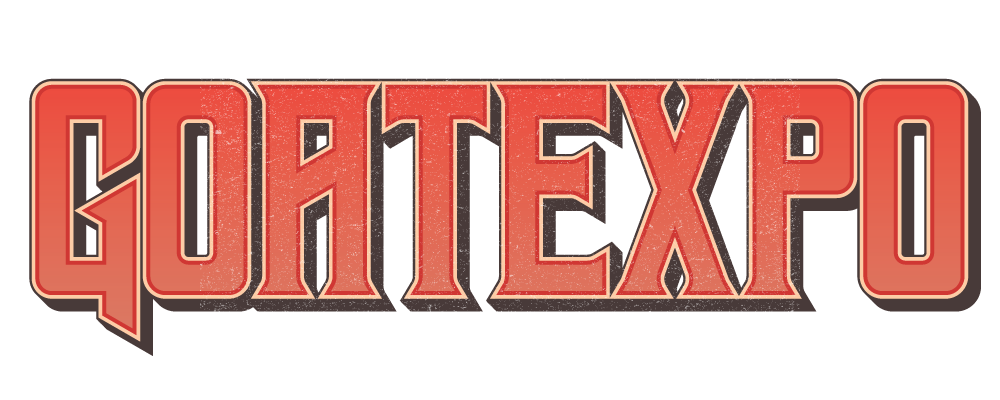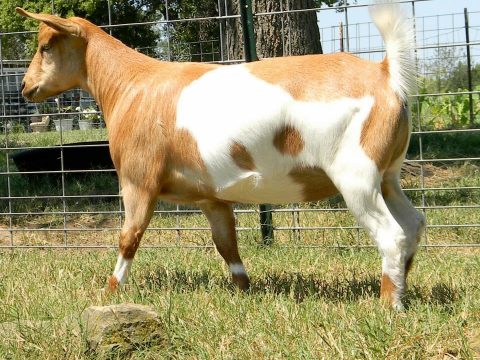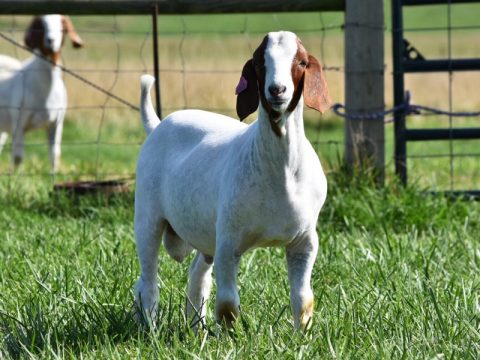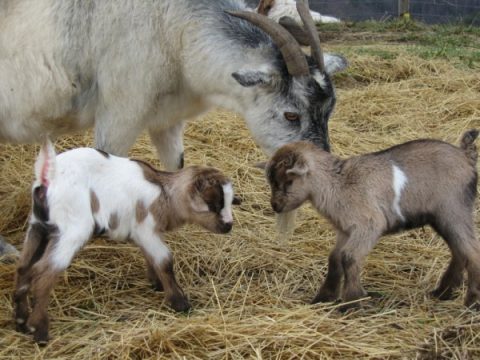
Dr. Frank Pinkerton – #4
4. Profiling the Meat Goat Industry
Introduction
The purpose of this article is to acquaint readers concerning certain structural and operational aspects of the meat goat industry. Many industry players, potential players, and agriculturally-oriented observers in general seem poorly informed concerning the purposes of the various types of meat goat enterprises. Accordingly, those considering getting into goats or expanding their present enterprises could possibly benefit from a brief review of historical goat enterprises.
Historical Context
Original European settlers coming to eastern coastal America brought “dual-purpose” goats (for milk and meat), while early explorers from Spain brought goats to the Caribbean and Mexico for meat and hide production. The descendents of this latter source became known, in Texas and the Southwest, as Spanish or Spanish-type goats and, in the Southeast, as brush or briar or hill goats.
Angora goats from Turkey were introduced around l900 and became concentrated in lesser rainfall areas of Texas, primarily the Edwards Plateau northwest of San Antonio. Texas. There were, and are, small numbers of Angoras in New Mexico and Arizona; Oklahoma, Michigan, and Missouri had small numbers in the eighties, but they have all but disappeared.
Dairy goat breeds were imported from England, Switzerland, France, and Egypt in the early 1900’s and became widely diffused thereafter as purebreds and as crossbreds with domestic ‘dual-purpose’ goats from colonial days.
Dairy Goats
USDA/NASS census figures indicate that dairy goat numbers grew from about 150,000 in 1992 to 335,000 in 2009; the increase from 2008 was 4%, and this trend has continued. There are six recognized breeds (Nubian, Alpine, Saanen, Toggenburg, LaMancha, and Oberhasli) and various crosses. Nubians and Alpines are the most prevalent.
Surplus kids and unproductive adults from the typically small herds enter the goat marketing channels via on-farm sales or brokers/traders or auction venues. Nubians and Nubian crosses are commonly thought to provide the “meatiest” carcasses; however, bloomy young milk-fed kids of any dairy breed typically command a price/lb equal to meat-type goats of similar age/size (with the exception of Boer goats).
Some portion of male dairy kids may not be retained and raised for meat purposes because of unfavorable cost-benefit ratios, i.e., the milk required to raise a kid to weaning at 8-12 weeks of age may have more worth as fluid milk/cheese than as feed for kids. But, given the recent high prices for young, high quality kids, particularly at Easter and Christmas, this situation could well change. Moreover, there is thought to be increasing use of Boer sires on dairy does of moderate to low production to produce a highly desirable market kids
Angora Goats
Angora goat numbers peaked in the mid-sixties at 5.5 million, and thereafter gradually fell, for various reasons, to just under 2 million by the mid-nineties. At that time, the USDA eliminated the Wool and Mohair subsidy program and numbers dropped sharply, reaching 185,000 by 2009; current number range around 150,000. While TX had, and has, the most Angora goats, small numbers are still found in NM and AZ; the modest surge in mohair production seen in OK, MI and MO seen during the eighties has all but disappeared.
Angora goat enterprises generated mohair for sale at world market prices for mostly international usage. Producers received additional, substantial income via the Wool and Mohair Act until 1995. Such enterprises also generated income from sale of surplus breeding stock and from salvage value of animals culled for poor mohair yield and/or quality. The culls moved via auctions to packers and, via urban retail outlets, to consumers. Until the mid-eighties, the vast majority of domestic goat meat eaten by consumers was from Angora goats with Spanish-type goats and dairy stock supplying the remainder. Currently, the major supply of goat meat comes from “meat-type” goats with perhaps the largest component of the annual national kill being Boer-cross animals.
Meat Goats
As indicated previously, for many years Texas goat enterprises focused on production of mohair. However, many such enterprises also raised relatively small numbers of Spanish-type goats, mostly for on-farm consumption or for on-farm sales. At times, somewhat larger volumes were sold through local auctions where most were bought and transported to distant packers; yet others were purchased by other ranchers for brush and weed control.
Scattered smaller herds of Spanish-type goats were also raised and similarly merchandized by farmers in the southeastern states and elsewhere. All such goats were usually minimally managed, if at all, with very limited inputs throughout the year. Consequently, reproductive efficiencies, off-take rates, and average weaning weights were typically quite low; not surprisingly, such practices frequently resulted in little or no profit to owners.
For some 25 years following WWII, 3-5 month old weanling kids weighing from 20/40 pounds could be bought at farms and ranches for perhaps $3-7/head, but by the early eighties such goats were selling for about $12-15/head. Thereafter, as Angora goat numbers continued to decline, Spanish goats increased in quantity and value with slaughter kids increasing to perhaps $18-20/head–or more, at certain holiday periods.
By the early nineties, light weight Texas slaughter kids were bringing around $25-30/head but, as Angora goat numbers fell precipitously after l994, slaughter kid prices moved sharply upward. In response to this novel marketing incentive, numbers of meat-type goats also increased markedly as producers initiated improved production practices to increase the efficiency and scale of their growing meat goat enterprises.
Starting in the mid-nineties when Boer goat genetics were introduced from South Africa and became increasingly available, widespread crossbreeding with Spanish goats began. Industry players now estimate that 75% or more of slaughter kids moving at public auctions show Boer goat influence.
Currently, considerable uncertainty exists among commercial goat owners as to the ‘proper’ percentage of Boer in their base doe herd, but, generally, the feeling is that the better the forage base, the higher the percentage Boer permissible. Half-bloods are probably the most numerous, but 3/8 to 5/8 crosses are also seen. Ranchers may use purebred or high-crosses for making terminal crosses. In any case, there are few, if any, “full Boer” slaughter goat operations to date.
The Kiko breed, introduced from New Zealand in the early nineties, has also been used in various venues for crossbreeding/upgrading and for purebred production, as have Tennessee Myotonic (stiff-leg or fainting) goats and Savannahs. A number of entrepreneurs have used Boer bucks as terminal sires on Kiko x Spanish does or Kiko sires on Boer-Spanish crosses to good effect. Readers should recognize that the volume of industry speculation far exceeds any necessary “proof-of-the-pudding” data as regards the economically optimum choice among the many crossbreeding program options available to producers everywhere.
Types of meat goat enterprises
Commercial meat goat enterprises, which account for the overwhelming majority of national numbers, may be conveniently, if imprecisely, characterized as to purpose, scale, and scope. Their primary purpose is to produce slaughter kids, but they may also generate surplus foundation (breeding) animals for sale, and about 20% of the doe herd is sold annually as cull animals. These enterprises range in size from less than a 100 to a 1,000 does (or more), but, large or small, most feature “extensive” pasture or range management schemes using native, perennial grasses and/or browse, plus minimum supplemental protein and energy feeds as forage availability decreases seasonally.
Generally speaking, health care costs, particular for internal parasite control, tend to rise with increasing rainfall levels across extensively (and intensively) managed venues. On the other hand, the poorer the average rainfall, the greater the tendency to select smaller, hardier breeds, or their crossbreds, as the base herd to compensate for limited forage yields and qualities.
Well-managed commercial enterprises can, over the years, generate weaned kid crops (average kid weight 40/50 lbs) ranging from 100 to130 % per year under extensive conditions (from a mixed-age doe herd). To achieve higher weaning rates (150% and up) and also get atypically heavier weaning weights (50-60 lbs), managers would have to increase production inputs substantially; resultant cost-benefit ratios realized are usually positive, but not always.
Commercially managed does usually kid between 12 and l8 months of age and typically average five sets of kids before going to slaughter at 6-7 years of age; productive 9-10 year old does are somewhat rare. Infertility, bad udders, low milk production, poor mothering ability, disease, parasites, predators, etc. all contribute to disappearance rates of does.
A majority of extensively managed herds have historically kept bucks with the does year round. This typically results in a large kidding wave from early Dec to late Feb with a smaller wave in late spring. However, given the recent price incentives for kids born “out-of-season” to target winter slaughter sales, some change in kidding seasons may be in the offing. This is accomplished by the use of planned-mating practices in which bucks are used only in certain seasons of the year.
Regarding the economics of commercial kid production, three crucial management factors largely determine the break-even price of a kid at sale time. These are: the annual maintenance cost of the does, the percent kid crop sold, and the weights and grades of kids sold. The profit per kid is calculated as the dollar difference between its break-even price and its net sale price/lb. Readers should realize that commercial, extensively-managed intensively-manager operations vary widely in their average annual doe maintenance costs, but, if this cost can not be held below $80-100/head, it will be difficult to realize acceptable profit levels. It would also be difficult if the enterprise could not average at least 150% kid crop sold; well managed herds may achieve 175 to 190% kid crop; 200% is rarely achieved.
Readers should understand that an accurate annual maintenance cost/doe can be calculated only if all expenses of the goat enterprise are totaled for the year and divided by the number of breeding age does in the herd on January 1. I recommend that you personally undertake such a challenging, enervating calculation only if you have a high pain threshold and no history of cardiac difficulties. Believe it or not, $40/50 profit/doe/year in commercial operations would be considered very acceptable indeed by their owners (and a figment of their imagination by goat-country bankers).
In addition to the commercial slaughter goat enterprises just described, there are a number of other types of goat enterprises which together account for a substantial part of the national meat goat population. They may be conveniently categorized by their primary purposes, as shown below.
Purebred meat goat enterprises are those which generate purebred animals, primarily for sale as breeding stock. Currently, purebred Boer goat herds and their aggregate numbers far exceed the counts of purebred Kikos, Myotonic Goat, and Savannahs. Knowledgeable industry players/observers are able to distinguish, however imperfectly, among certain sub-categories of purebred goat enterprises.
They do this by making comparisons concerning an owners’ major Show “standings”, who sells to/buys from whom and at what prices, who has the most ‘popular’ bloodlines, who bought from what country-of-origin, breeder reputation, etc. Descriptive terms such as Foundation Stock Breeders or Seed Stock Producers or Elite Breeders are used to denote this relatively small group of players.
From these elite herds, a second tier of breeders purchase foundation stock in order to expand numbers which are then offered for sale to each other, to other (usually) smaller breeders, and to the much more numerous producers of commercial goats wishing to “upgrade” their herds via use of purebred sires and occasional dams. Looking nationally, one can discern still other sub-categories of purebred Boer goat enterprises–largely by noting certain characteristics: size of operation, prices levels paid/received, marketing targets, extent of participation in local, regional, or national Shows, attendance at local and regional Field Days, Seminars, etc.
Smallholder meat goat enterprises account for a growing portion of the national meat goat herd. Most tend to be intensively managed operations with much smaller herd sizes and fewer land resources employed as contrasted to the extensively managed commercial operations earlier described. If well-managed, average herd performance, as measured by off-take, sales prices received, cash flow, and net profit, can equal, or exceed, that of larger extensive operations on a per head basis.
Herd sizes usually range from 25 to 100 does, and stocking rates of 5, even10, head per acre are not uncommon. Such enterprises are widely dispersed, from eastern Texas throughout the southeast and, increasingly, in the northeast, mid-Atlantic, the corn-belt, and elsewhere. Smallholder enterprises typically utilize Spanish-type goats or crossbreds as their base herd and use purebred bucks, of whatever breed, to produce kids for the slaughter market (or other sales targets).
While such enterprises are intended to at least breakeven or yield at least a modest annual profit, some do, but some do not (especially so when inequitable marketing opportunities are encountered). In any case, there is great variation within and between smallholder herds over time and place as to production and marketing practices, as also to economic viability.
In those cases in which such enterprises remain unprofitable over time, they are more accurately described as hobby goat operations. And, while these may consistently lose appreciable money, hobbyists may also garner “non-cash” satisfactions from goat ownership activities. The phrases: fun time, family interaction, shared responsibility, constructive work, personal dependability, cooperative endeavors, appreciation for nature, enjoyable exercise, learning experiences, etc. are often heard concerning such endeavors. At the end of the day, one can ask, but rarely get a precise answer to, the question of: just how valuable, really, is this goat experience, and to whom? Be that as it may, the annual off-take from such herds does contribute substantially to the national kill.
Wether goat enterprises are an increasingly important segment of the meat goat industry. While Texas leads the nation in number of 4-H/FFA youth projects featuring wethers shown in weight-based slaughter classes at organized, premium-paying Shows, project numbers are now expanding sharply in other states as well. Note that the recommended practices for selection, management, fitting, showing, and judging of project animals may be quite variable within and between states. Don’t go uninformed into this situation; the learning curve may be more than one can comfortably tolerate.
In any case, virtually all these project animals are finally sold for slaughter, albeit often at penalty prices because of too large weights, over-fat condition, and shorn status (price disincentives may reach 30 cents/lb under similar weight goats). The annual national kill of such goats has been estimated to be near 100,000 head (for comparison, the total federal/state-inspected goat kill in 2014 was over 800,000 head).
Readers should understand that the stated purpose/objective of such projects is, generally speaking, youth education (however locally defined). Wether goat projects only rarely realize a profit to the youthful players, i.e., return a sum exceeding the cost of the goat, feed bill, health care, etc. unless, of course, the animal places sufficiently high in the contest to attract unusually high bids from the usual post-Show public sale. Such buyers, be they businessmen, professionals, or doting grandparents, are prone to pay prices well beyond slaughter values. Such inflated prices, in turn, encourage ever higher prices to be paid for prospective project-goats the following year. (Some have said, ungraciously, that such events can instill a gambling instinct in innocent minds, not all of whom are children).
In any case, astute entrepreneurs seek to meet this rising demand by creating superior show prospects via genetic selection and improved management. Indeed, there are now a substantive number of enterprises whose paramount purpose is to provide Show prospects for this emerging market. A number of purebred enterprises and smallholder operations also engage in this endeavor, often as a corollary to their major activities.
Readers should be aware that there is considerable, on-going industry discussion and dispute regarding the most desirable phenotype (“the looks”) of wethers for Shows. Requiring follow-up carcass evaluations to visually compare and mathematically correlate live placing with carcass placing or % yield of lean meat would be a most useful procedure to objectively identify those Show and/or carcasses characteristics of actual economic concern to processors and consumers. However, this is not thought likely to happen, largely because of parental and Extension leadership opposition.
Conclusion
This article describes the major types of the national meat goat industry and briefly characterizes them as to scale and primary purpose. As seen from the perspective of the last decade, a number of substantial and on-going changes in the goat industry have occurred; as a result, certain future trends now seem discernible. For example:
1) Total goat slaughter in federal and state-inspected plants increased to 2008 but has declined by 2-3% as producers in the southeast and elsewhere have decreased off-take in the face poor returns to labor, management, and capital.
2) Total meat-type goat numbers are slowly increasing relative to dairy goats and Angora goats.
3) There has been a noticeable shift from predominantly Spanish-type slaughter goats to crossbred animals showing substantial Boer, Kiko, and Savanna breed influence.
4) Imported goat meat tonnage steadily increased over the last decade as domestic production and slaughter declined relative to ever increasing demand; we now produce only about half of our consumption; the remainder comes mostly from Australia. Some 100,000 domestic goats are sold annually without passing through state and federal slaughter plants; thus our actual percentage of domestic slaughter is not precisely known.
5) Ethnic populations (major consumers of goat meat) are increasing rapidly in total numbers and as a percent of the U.S. population; their disposable income/family is also increasing as they participate more equitably in the work force.
6) More and more goats are being marketed by weight and grade rather than by the head; improvements in prices paid to producers have usually, but not always, reflected this change; winter prices for slaughter typically exceed previous summer prices by 25-30%
7) Prices received by producers have trended upward as domestic production has fallen relative to total consumption. Historically, however, consumers of other red meats have demonstrated considerable purchasing resistance in certain markets when prices became, in their opinion, exorbitant. Such might be the case even among our traditional customers for goat meat, but current retail prices (well over $6.00/lb retail) are still ‘clearing the market handily’—a sure sign that supply is not exceeding demand at this time.











